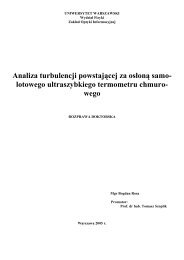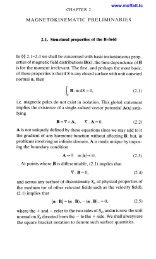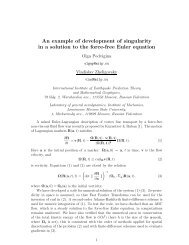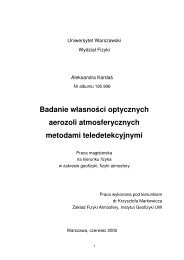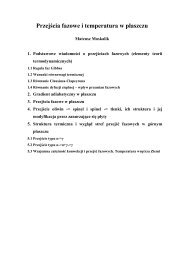A similarity solution for viscous source flow on a vertical plane
A similarity solution for viscous source flow on a vertical plane
A similarity solution for viscous source flow on a vertical plane
You also want an ePaper? Increase the reach of your titles
YUMPU automatically turns print PDFs into web optimized ePapers that Google loves.
40 B. R. Duffy and H. K. Moffatt<br />
of the c<strong>on</strong>tact-angle, and merely report a family of free-surface profiles that are c<strong>on</strong>sistent<br />
with (2.2)–(2.5), and <str<strong>on</strong>g>for</str<strong>on</strong>g> which, as we shall see, β is variable.<br />
We seek a <str<strong>on</strong>g>similarity</str<strong>on</strong>g> <str<strong>on</strong>g>soluti<strong>on</strong></str<strong>on</strong>g> to (2.2) of the <str<strong>on</strong>g>for</str<strong>on</strong>g>m<br />
h(x, y) f(x) G(η),<br />
η yy e<br />
(x),<br />
so that G(1) 0.<br />
Substituti<strong>on</strong> of this <str<strong>on</strong>g>for</str<strong>on</strong>g>m of h into (2.2) shows that appropriate f and y e<br />
are<br />
f(x) A(cx)m, y e<br />
(x) (cx)n, m4n1 0,<br />
where c, A, m and n are c<strong>on</strong>stants (a shift of origin having been made, to eliminate any<br />
additive c<strong>on</strong>stant in x). The c<strong>on</strong>stancy of Q further implies that 3mn 0, so that<br />
m 113 and n 313. The c<strong>on</strong>stant A( 0) may be chosen freely, and if we make the<br />
choice A cρg sin α104γ (so that c and A have physical dimensi<strong>on</strong>s (length)/ and<br />
(length)/, respectively) then the equati<strong>on</strong> <str<strong>on</strong>g>for</str<strong>on</strong>g> G(η) is<br />
GG3GG24(G3ηG) 0,<br />
i.e.<br />
G(G24η) c<strong>on</strong>stant.<br />
For the symmetrical <str<strong>on</strong>g>soluti<strong>on</strong></str<strong>on</strong>g>s that we are c<strong>on</strong>sidering here, we have G 0 when η 0,<br />
so that the c<strong>on</strong>stant of integrati<strong>on</strong> is 0. Thus G 24η, and, trivially, the <str<strong>on</strong>g>soluti<strong>on</strong></str<strong>on</strong>g><br />
satisfying G(1) 0is<br />
G(η)(η1)λ(η1), (2.6)<br />
where λ is some c<strong>on</strong>stant. The flux c<strong>on</strong>diti<strong>on</strong> gives a relati<strong>on</strong> between c and λ:<br />
(ρg sin α) c<br />
Q <br />
2313γµ G dη, (2.7)<br />
−<br />
which reduces to c P(λ) Nγ µ Q, (2.8)<br />
(ρg sin α)<br />
where N 235713 3690960 and<br />
P(λ) λλ<br />
λ . (2.9)<br />
This cubic polynomial P(λ) is m<strong>on</strong>ot<strong>on</strong>ic in λ, with real root λ ( 1.184). <br />
Thus, overall we have<br />
cρg sin α<br />
h(x, y) <br />
104γ (cx) −/ G(η), (2.10)<br />
where η yy e<br />
(x), y e<br />
(x) (cx)/, (2.11)<br />
with G(η) as in (2.6) and with (2.8) holding. The quartic functi<strong>on</strong> G(η) essentially gives the<br />
cross-secti<strong>on</strong>al shape of the trickle at each stati<strong>on</strong> x c<strong>on</strong>stant; we shall find interpretati<strong>on</strong>s<br />
of the <str<strong>on</strong>g>soluti<strong>on</strong></str<strong>on</strong>g> <str<strong>on</strong>g>for</str<strong>on</strong>g> both positive and negative values of the c<strong>on</strong>stant c, valid <str<strong>on</strong>g>for</str<strong>on</strong>g> G(η) 0





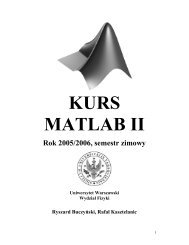
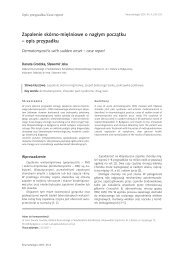
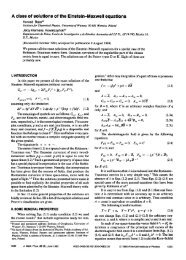
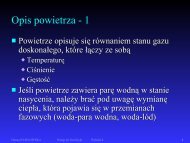
![slajdy [PDF, 0,6 MiB] - Instytut Geofizyki](https://img.yumpu.com/22546539/1/190x143/slajdy-pdf-06-mib-instytut-geofizyki.jpg?quality=85)
